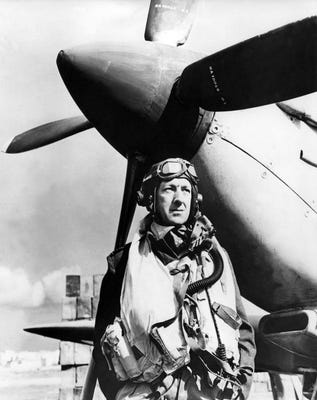source GAIA package: Sx_MilitaryTimes_M6201410306020048_5675.zip Origin key: Sx_MilitaryTimes_M6201410306020048 imported at Fri Jan 8 18:18:17 2016
 Former Marine Adam Driver may be the most recent veteran to join the cast and crew of the "Stars Wars" universe, but he's certainly not the first. In fact, it turns out the Force is strong in veterans.
Former Marine Adam Driver may be the most recent veteran to join the cast and crew of the "Stars Wars" universe, but he's certainly not the first. In fact, it turns out the Force is strong in veterans.
Indeed, real-life warriors — along with their more Earth-bound wars and warfighting gear — have shaped that galaxy far, far away in myriad ways.
Among just a few:
■James Earl Jones. Before his rumble of a voice gave Darth Vadar his iconic command intonation, Jones was an Army first lieutenant in the early 1950s.
■Alec Guinness. The greybeard version of Obi Wan Kenobi in the original movie, Guinness served in the British Royal Navy during World War II and saw duty in the campaign across North Africa, the allied invasion of Italy, and fighting along the coast of Yugoslavia.
■Irvin Kershner. Long before directing "The Empire Strikes Back," Kershner served as a flight engineer aboard B-24 bombers during World War II.
"I like to say World War II influenced more elements of 'Star Wars' than any other single thing. And if you expand that to the military in general, it's definitely true," says Cole Horton, a historian who writes regular blog installments on the topic for the official "Star Wars" website.
Drawing from a broad range of military surplus gear, for example, "Star Wars" creator George Lucas was able to give his universe an authentic look.
"It's the gritty, real-world feel to the original trilogy that set it apart from anything that ever came before it," says Horton. "This was an intentional design decision by Lucas, who wanted the 'Star Wars' universe to feel used and lived in; different, but familiar. So by using real things — and modifying them — he could get that."
For example, just look a little closer at Han Solo's trusty blaster. It's actually a German-made Mauser C96 semi-automatic pistol with just a few cosmetic changes.
Gun collectors might also recognize the Stormtroopers' preferred blaster, really a British-made Sterling L2A3 sub-machine gun. Watch closely in the original "Star Wars" and you'll see actual casings flying from the guns as actors used blank-firing models during combat scenes. Even the blaster scopes were pilfered from surplus World War II-era U.S. M-38 Wolfhound armored cars, says Horton.
A B-29 Superfortress pilot would feel right at home inside the cockpit of the Millennium Falcon. With a few special modifications of his own, Lucas transformed the flight deck of one of the most advanced World War II bombers into our front-row seat to hyperspace.
While the main structure of Solo's ship was made from scratch, much of its rich detail was added using existing military model pieces, says Horton. "On the hull of the Falcon, you will find pieces of Panther tanks, Tiger tanks, Messerschmitt 109 fighters, Kubelwagons, and many more," he writes in one StarWars.com blog post.
And while Solo was quick to brag that his favorite bucket of bolts could make the Kessel Run in less than twelve parsecs, an actual "kessel" run is a reference "to German pilots trying to supply troops encircled by the Soviet army after the battle of Stalingrad," writes Horton. "Kessel, or 'cauldron' in German, was the term used to describe any such encirclement."
Even the very fabric of the Star War story draws heavily from World War II, says Horton.
A teetering republic in which an unlikely politician rises to absolute power and the creation of an evil Empire is as much about Adolf Hitler as it is about Darth Vader's Sith overlord, Emperor Palpatine.
"Once in power, both dictators dissolved senates and government bodies and created internal enemies. Hitler murdered the leaders of his own Sturmabteilung in a very Star Wars-esque purging of the Jedi in Episode III. It just goes on and on like that," says Horton.
But it's the veterans themselves who breathe life into Lucas's creation.
Gary Kurtz, a Marine combat cameraman who served in Vietnam, was one of Lucas's early recruits, as producer for the original "Star Wars" and "The Empire Strikes Back." Several of the special effects wizards at Industrial Light and Magic, the company Lucas created while making the films, were also Vietnam veterans, Horton notes.
But perhaps the single most influential veteran was the very first person Lucas hired to help him bring his vision to life, says Horton.
Ralph McQuarrie saw combat duty in Korea while serving in the Army. After surviving a bullet wound to the head, he went on to art school to become an illustrator.
"He's considered the godfather of the 'Stars Wars' aesthetic," says Horton.
"McQuarrie was the first person I hired to help me envision 'Star Wars,' " Lucas said upon McQuarrrie's death in 2012. "His genial contribution, in the form of unequaled production paintings, propelled and inspired all of the cast and crew of the original 'Star Wars' trilogy. When words could not convey my ideas, I could always point to one of Ralph's fabulous illustrations and say, 'Do it like this.' "
:quality(70)/cloudfront-us-east-1.images.arcpublishing.com/archetype/JHEBPFB7RNHRPBX4VDQEXLKVZQ.jpg)
:quality(70)/cloudfront-us-east-1.images.arcpublishing.com/archetype/SPYQ3B4JVNBTZHMJ4MIOCN5LFE.jpg)
:quality(70)/cloudfront-us-east-1.images.arcpublishing.com/archetype/WH4J42XWGBFCZA5EAXE5DKBGQY.png)
:quality(70)/cloudfront-us-east-1.images.arcpublishing.com/archetype/KGFBZ2BV4FGTHBGUH2LLWP6JWA.jpg)
:quality(70)/cloudfront-us-east-1.images.arcpublishing.com/archetype/CGG7G2ZZEJGYPIXPTWEADGVIWE.jpg)
:quality(70)/cloudfront-us-east-1.images.arcpublishing.com/archetype/WFC36ILXGJACXAVJPGN3EWJQPU.jpg)